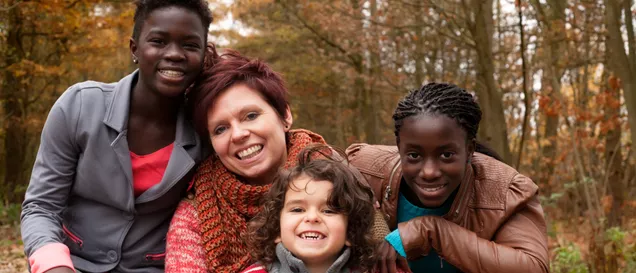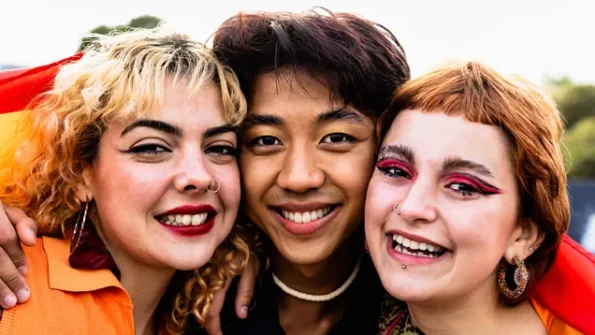
Importance of identity formation for children in care
What is the definition of identity formation?
Identity formation (or ‘identity development’) is the process where we begin to develop an understanding of who we are and how we fit into the world around us. This generally starts in adolescence and can be influenced by lots of things, both internal and external.
- Internal influences include gender, ethnicity, race, appearance, sexual orientation, hobbies, interests, and life experiences.
- External influences include family, friends, society, culture, religion, location, opportunities, and media.
While our self-identity will likely evolve over time, those with a deeper understanding of themselves will generally have greater self-belief, confidence and self-concept, and become more emotionally balanced adults.
Conversely, people with a poor understanding of their self-identity may experience increased levels of anxiety, low self-esteem, depression, social anxiety, a lack of confidence, and more. People who have a conflict with their identity or are existing between multiple identities (for example, people from dual heritage or those questioning their gender or sexual orientation) may also experience these issues too.
Interestingly, when it comes to child development and identity formation, we are born with simple identities that are generally self-serving – for example, we see our mothers purely as a person there to care for us and meet our needs. It’s only as we grow that we begin to understand identity in a more sophisticated and thoughtful way.
Racial and cultural identity formation
Karen Simpson is an MBACP accredited therapist whose worked with a number of children and teenagers in our care presenting with issues around culture and identity, low self-esteem, anxiety, depression, and more. Today, she explains the role of race, ethnicity and culture in identity formation, and how being in foster care may impact that.
Video transcription
So when identity formation starts – and it does start quite young – race, culture and ethnicity form your identity. It is literally who you are. You get your identity from your parents.
How foster care affects children’s identity development
How does being in foster care then impact children’s development of self-identity? Quite significantly, because when they look around, they might not see anyone who looks like them. Certainly, they won’t see their parents. They won’t figure out which character traits are like their parents, for instance, which is another big part of identity.
Being in foster care already puts the child at a disadvantage in terms of attachment and identity, because being removed from the people who created them comes at a huge sense of personal loss. So there is an immediate loss of identity when being moved into care. There’s certainly a loss of “who am I?”
When a child’s ethnic identity is different to their foster family
If a child is not culturally matched, they might have to adapt to the family they are in. So when they come to figure out who they are; their likes; their dislikes; their character traits; what makes them laugh; what makes them sad; what they enjoy; the foster family has a huge role to play in incorporating what they like, and not making it different, othered, or wrong.
I’ll give you an example; a Black child might like rap, grime and R&B music, and they might turn it up high. But if the foster family like pop music or a different genre of music, then they might be like: “What is that?”; “I can’t understand a word they’re saying”; “Turn that off”; “Why do you listen to that?” That’s impacting the child’s development of identity.
They might then reject that part of them – the part that likes that kind of music – or they may feel like they have to keep it a secret and start putting their headphones in. And just like that, the foster family are excluded from that part of them. The same might go for food and dating, and intercultural dating comes in here as well.
How foster parents can support children from different ethnic backgrounds
The work for us, as therapists and foster carers, is to celebrate our young person and who they are. Praise them and encourage them to explore their identity – particularly for children of mixed heritage, who might have contact with white families more than they have contact with the black side of their families, or vice versa.
If a child is not getting any input into who they are, they are going to look to the media; they’ll go to YouTube, music and popular culture to figure out who they are and find out ‘what black people do’. For example: “As a black person, I see that we like this kind of music; this kind of dance; this kind of food; this way of worshipping; our faith hangs on this.” And so the ideas and customs that make a culture are what they’re going to be drawn to.
Can the foster family facilitate that? I hope so. Take them to different concerts, even if you can’t understand a word the artist is saying, because it’s not for you, it’s for them. Take them to salons that do black hair really well. Introduce new foods and ways of cooking. Get a takeaway that allows a whole family to experience different foods from different cultures.
Just be really open-minded because in that way you are saying to the young person non-verbally: “I recognise you are different and I want to honour that. I don’t want to make you like us because you are not like us. But we all matter and we are all important. And so that’s why I’m going to celebrate who you are”.
Continue reading…

Importance Of Diversity In Foster Care
Karen Simpson discusses the importance of diversity and representation for all children within foster care and how to introduce ethnic and cultural differences to children.

Fostering Children From Different Race Or Religion
Discover why it’s important to learn about the child’s background to be able to meet not just their physical needs but their emotional needs too.
Gender and identity formation
Another key part of identity formation is gender. Babies are assigned a sex when they’re born depending on physical characteristics – this will be male or female. However, during their development, a child may begin to feel a disconnect between their assigned gender and their gender identity.
Gender identity development in children typically starts around the age of two, when they begin to notice physical differences between boys and girls. Generally, by the age of 3, they’re able to label themselves as either a boy or a girl, and by 4, they’ll likely have a stable sense of their gender identity.
Children express their gender identity in many ways. For example, the clothes they wear, their hairstyle, the name they like to be called, their style of behaviour, play and social interactions, and the gender of those they choose to play with. However, it’s also a perfectly normal part of gender development and exploration to flit between the two, and often, they will go on to feel comfortable with the gender they were assigned at birth.
Gender-diverse children can be aware they are different to their assigned gender from the age of 2-3. For example, they may get angry or upset if you call them their assigned gender or they might refuse to wear particular clothes. They may also begin talking about their gender identity later in life, in primary school, teenage years and even adulthood.
As a foster parent, it’s important you continue to have age-appropriate conversations with your child about gender, and make space for gender exploration in your home. If a child in your care is gender diverse, then there are lots of ways you can support them, from asking your child about how they want to be addressed, to speaking to their teachers so they can provide better support for your foster child in school.
Sexual orientation development
While gender identity development typically happens from around the age of 2 to 3, sexual orientation generally begins to form around puberty – and most teenagers will question their sexual orientation in one way or another throughout adolescence.
Some may be clear and open about their sexuality early on in their teenage years – whether that’s heterosexual, bisexual, homosexual, or any other sexual orientation – however, others may be less certain. This can be incredibly confusing and sometimes distressing, particularly if they’re fighting against that part of their identity.

One of the other difficult times a young person from the LGBTQ+ community will face is there ‘coming out’ journey, and often they will have to repeat this numerous times to different groups of people and individuals. Childline reported this as the top concern for LGBTQ+ young people in 2020/21.
As foster parents, one of the most important things you can do is to create a supportive environment at home where they feel comfortable talking to you about their sexuality and really listen to how they feel. They may also want your help in telling other friends and family, but be guided by the young person in your care and the pace they’re comfortable with.
Join our team
Looking to join a foster agency that inspires, supports and teaches? Here at ISP fostering, we’re always on the lookout for talented foster parents who want to further their careers with new challenges and a strong support network that can help them thrive and care for children around the UK that need that extra bit of support.
Find out more about transferring to ISP fostering by calling us on 0800 0857 989 or contact us online and we will call you back
